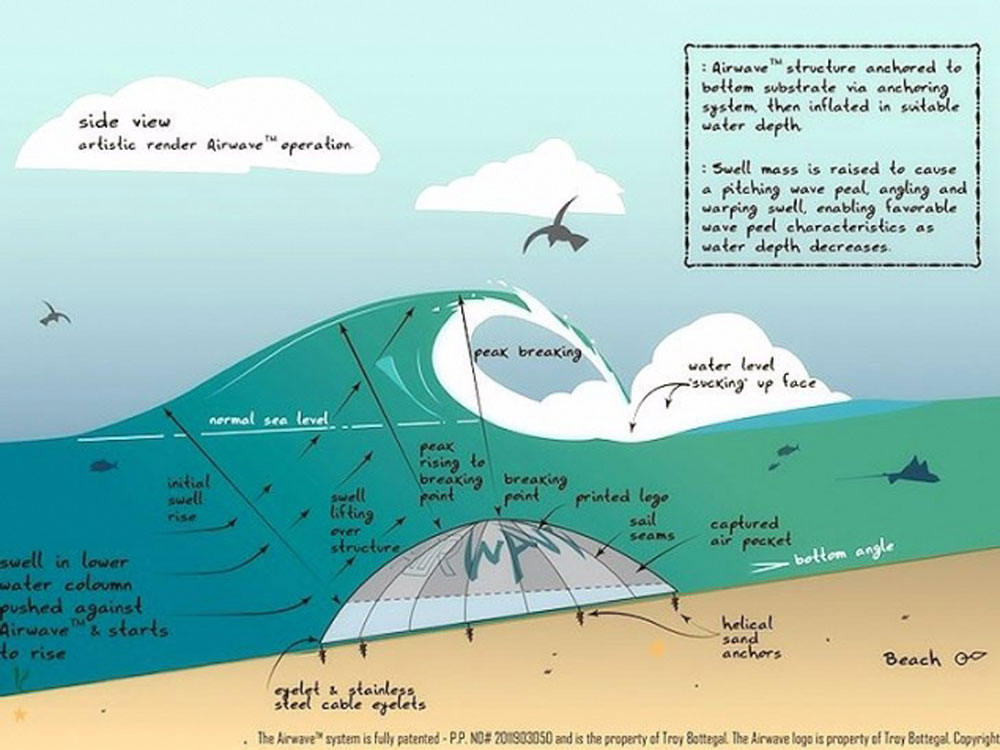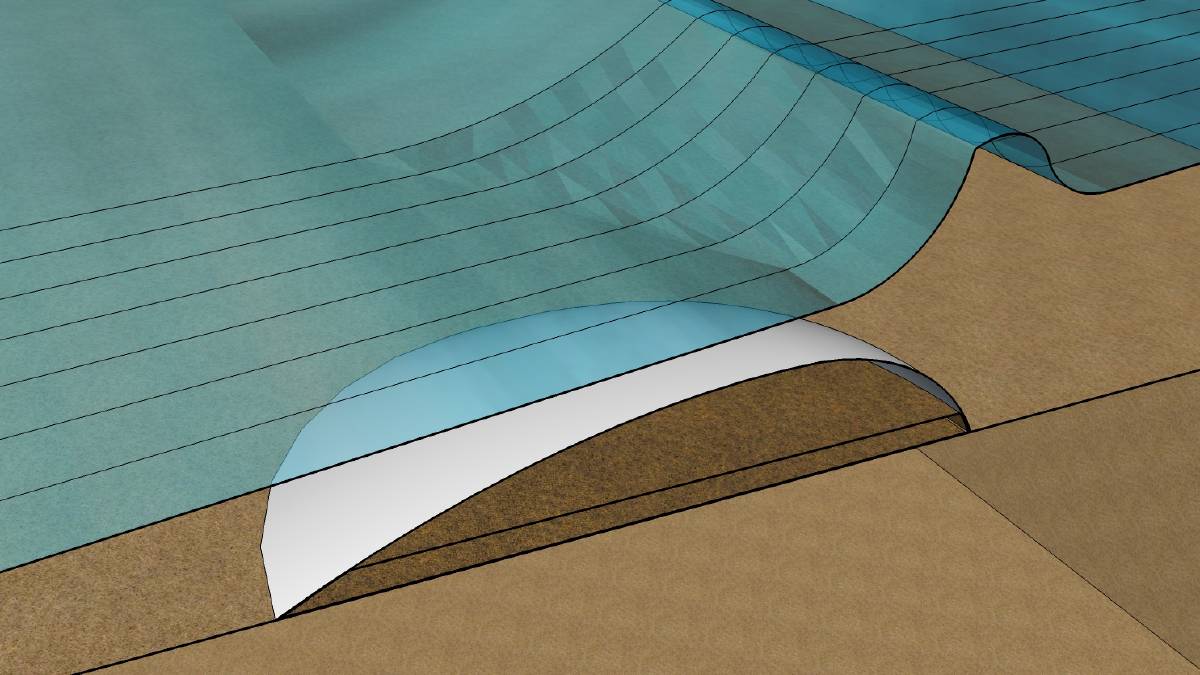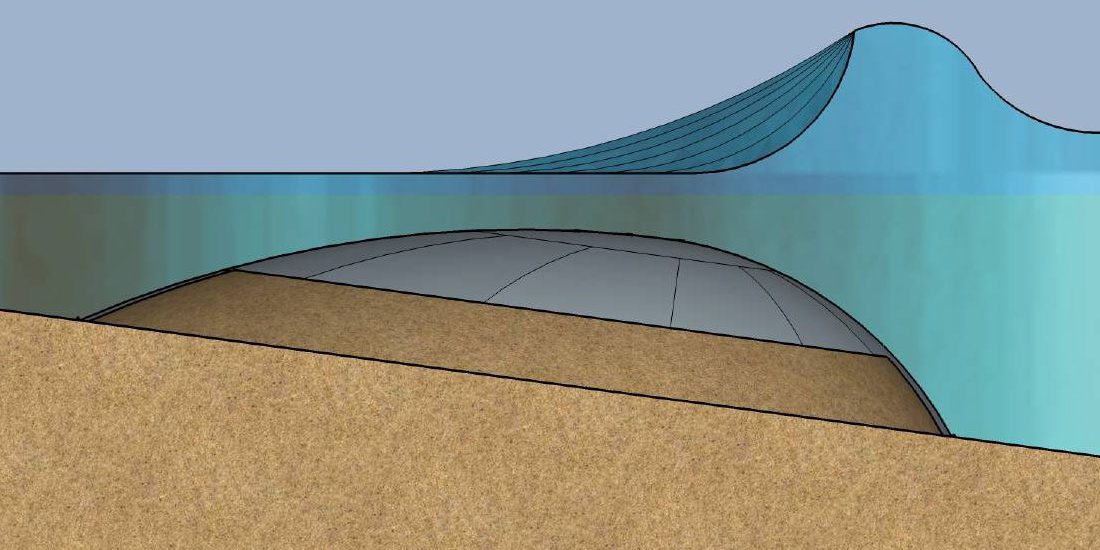Given approval to build, inventor seeks funding.
Troy Bottegal is the driving force behind making the Airwave artificial reef concept a reality.
Given the recent go-ahead by Bunbury, in Western Australia, Bottegal believes he’s cracked the formula to turn closeouts into quality A-frame peaks.
Inflatable reefs, quickly and inexpensively installed, able to be removed should they fail to perform as desired—Bottegal’s dream promises to avoid the problems associated with previous artificial reef attempts.
The only barrier to execution remaining is funding, which he hopes to overcome via his recently launched Kickstarter campaign.
Whether Bottegal can take the project from its conceptual stage out into the real world remains to be seen. But he’s a man with a vision and drive and if anyone can turn an idea born from a post-surf tub soak into a functioning wave, it’s most likely him, so we hit him with some Q’s.
The drive behind the project
The initial ‘why’ spark for the inflatable artificial surf reef came from my personal frustration at the lack of quality beach breaks in Perth…. a place with beautiful white beaches and a fair bit of swell, but a ridiculous shortage of quality waves.
At that time, I had to live in Perth for work, and really didn’t want to contemplate a future of repeatedly trudging down to beach to ‘get wet’, roll my arms over, then go home. It was like I was starring in my own morbid version of Groundhog Day.
The predominant science around wave creation at the time was huge artificial surf reefs made from ‘enviro-mesh’ sand bags, touted by the New Zealand company ASR. A few of them had been installed and the results were uninspiring to say the least. They also cost many millions of dollars to install, money that most councils do not have.
The light bulb moment…
I was in the bathtub, after a particularly underwhelming session in two foot mush. I was depressed, fat, and staring at my swollen belly and spaghetti arms.
We had one of those dome shaped, oyster light fittings over the bathtub and when I looked up at it, the idea just hit me.
I stared at it for what felt like a long time, then I jumped up, unscrewed the fitting, dropped it in the bath and had a great time for about 15 minutes pushing slow waves at it and visualizing a surf break with a reef shaped like my light fitting.
The Airwaves basic shape has evolved from that beautiful piece of smoked glass.
 Environmental impact
Environmental impact
With the Airwave design, I tried to make something that was as environmentally inert as possible while still delivering something akin to the surfing holy grail… namely a wedging a-frame that peeled all the way to the beach.
I worked on a low curve dome shape, that had an abrupt curve in the deeper water at the back, and the rest of the structure was designed to soften the blow on the environment.
There is a lot of speculation about the Airwave’s ability to be able to maintain its viability and position in rough seas, storm events, and withstand the effects of long shore sand drift. Without going into the IP of how we anchor the unit, exactly, the Airwave has a huge base footprint, partially filled with sand, and a very subtle low curve. This makes it act almost like a huge mollusc on the bottom. I believe this feature alone makes it extremely resistant to those forces that would normally see the undoing of other structures.
In designing the Airwave shape like this, and also making it ultra-removable, we have effectively solved the environmental problem before it became one.
It has made the application process, that we will be documenting and using again as a blueprint for future installations, with the Bunbury City Council in Western Australia a much smoother process.
Obviously testing will allow us to see the ultimate results, however I am confident it will prevail in the environment we place it in. If they don’t do what you want them to do, or prove to be an environmental nuisance, they take half a day to move.
Development
Cost wise, each Airwave will sell for around US$350,000; around 1/20th of the cost of a conventional artificial surf reef.
You can install multiple Airwaves along the entire length of a beach in a very short period of time, creating multiple peaks. Beaches that are full of a-frames attract all sorts of people out of houses, away from bongs and meth pipes and into the environment that we know and love, the ocean.

Kickstarter
I am looking to self-fund the world’s first real Airwave test. We can tank test smaller versions until we’re blue in the face and out of money and all we would have proven is that little Airwaves work in little tanks.
I’ve done enough scale testing to be very confident of a full scale result. Imagine pulling up in the car park of your local beach to find it filled with perfect peaks, every time you drive down there to check the swell. I think that’s worth donating for.
If you’d like to donate to the blow up reef cause, head here.

